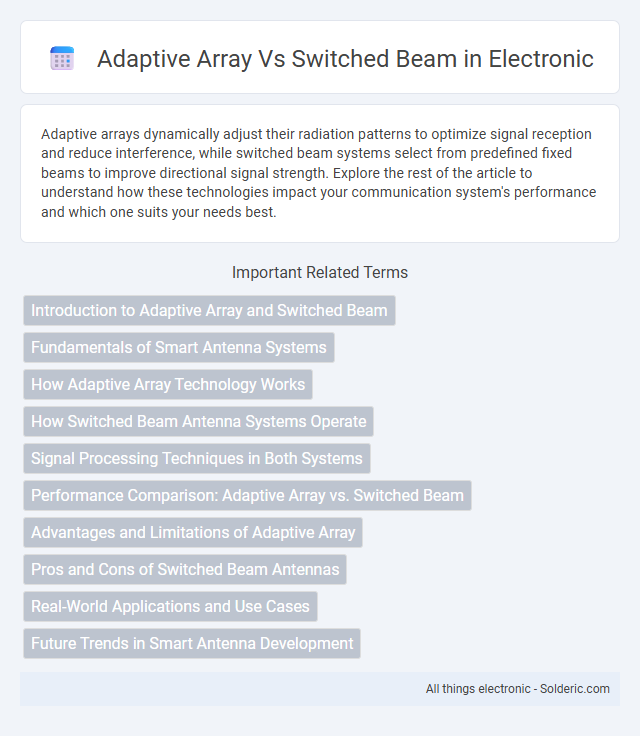Adaptive arrays dynamically adjust their radiation patterns to optimize signal reception and reduce interference, while switched beam systems select from predefined fixed beams to improve directional signal strength. Explore the rest of the article to understand how these technologies impact your communication system's performance and which one suits your needs best.
Comparison Table
| Feature | Adaptive Array | Switched Beam |
|---|---|---|
| Beamforming Technique | Dynamic, continuous adjustment of antenna weights | Selection among predefined fixed beams |
| Interference Mitigation | High, adapts to interference environment in real-time | Moderate, limited by fixed beam patterns |
| Complexity | High processing and implementation complexity | Lower complexity, easier to implement |
| Performance | Superior signal quality and capacity enhancement | Improved performance by beam switching but less optimal |
| Cost | Higher due to advanced processing requirements | Lower, using simpler hardware |
| Use Cases | Advanced communication systems, radar, 5G networks | Basic wireless networks, legacy systems |
Introduction to Adaptive Array and Switched Beam
Adaptive arrays dynamically adjust their antenna patterns to optimize signal reception and interference suppression based on real-time environment changes. Switched beam systems select from a predefined set of fixed beams to improve signal quality by directing focus toward a target area without continuous adjustment. Understanding these technologies enhances your ability to choose the best antenna system for improving wireless communication performance.
Fundamentals of Smart Antenna Systems
Adaptive array antennas dynamically adjust the phase and amplitude of each element to optimize signal reception and interference suppression, enhancing spatial filtering through real-time beamforming algorithms. Switched beam systems use multiple pre-defined fixed beams, selecting the best beam direction to improve signal quality without continuous adaptation. Smart antenna systems leverage these fundamentals to enhance wireless communication by increasing capacity, coverage, and signal reliability through advanced signal processing techniques.
How Adaptive Array Technology Works
Adaptive array technology uses multiple antennas that dynamically adjust their signal patterns to optimize reception and transmission by continuously analyzing the signal environment. This approach enables the system to form nulls towards interference and enhance gain in the direction of the desired signal, improving overall signal quality and reducing noise. Unlike switched beam systems, which select from fixed beam patterns, adaptive arrays actively modify their beamforming weights in real time to respond to changing signal conditions.
How Switched Beam Antenna Systems Operate
Switched beam antenna systems operate by selecting one of several fixed beam patterns to focus the antenna's radiation in the direction of the desired signal, enhancing signal strength and reducing interference. These systems use multiple predefined beams formed by an antenna array, switching between beams based on signal quality or direction of arrival measurements. The operation relies on quickly steering the main lobe towards the strongest signal without continuously adapting the beam shape like adaptive arrays.
Signal Processing Techniques in Both Systems
Adaptive array systems utilize advanced signal processing techniques such as adaptive filtering and spatial correlation to dynamically adjust antenna weights, optimizing signal reception and interference suppression in real-time. Switched beam systems employ predefined beam patterns with simpler signal processing algorithms, selecting the best beam based on signal strength measurements rather than continuous adaptation. Your choice of system impacts the complexity and responsiveness of signal processing, with adaptive arrays offering superior performance in dynamic and interference-prone environments.
Performance Comparison: Adaptive Array vs. Switched Beam
Adaptive array systems dynamically adjust their radiation patterns to optimize signal reception and interference suppression, resulting in superior performance in complex and rapidly changing environments compared to switched beam systems. Switched beam arrays, using predetermined beam directions, offer simpler implementation but may suffer from reduced accuracy and slower response to signal variations. Your choice between these technologies should consider the need for real-time adaptation and precision in signal tracking versus system complexity and cost.
Advantages and Limitations of Adaptive Array
Adaptive array systems dynamically adjust signal patterns to optimize reception and reduce interference, providing superior performance in cluttered or rapidly changing environments compared to switched beam systems. Your communication gains enhanced signal quality and resilience as adaptive arrays continually steer beams toward desired signals and nullify noise sources, though this complexity demands higher processing power and cost. Limitations include increased system complexity, potential computational delays, and greater power consumption relative to simpler switched beam arrays.
Pros and Cons of Switched Beam Antennas
Switched beam antennas offer a simpler, cost-effective solution by selecting from a predefined set of fixed beams, providing moderate directional gain and interference suppression. Their main advantage lies in ease of implementation and lower power consumption compared to fully adaptive arrays. However, switched beam systems lack the fine-tuned spatial filtering and dynamic adaptability to signal changes that adaptive arrays provide, potentially leading to less effective performance in complex or rapidly changing environments impacting Your communication quality.
Real-World Applications and Use Cases
Adaptive array systems excel in complex environments like military radar and wireless communications by dynamically adjusting beam patterns to mitigate interference and enhance signal quality. Switched beam systems find practical use in fixed infrastructure, such as cellular base stations, where predefined beam directions optimize coverage and reduce interference in known traffic patterns. Your choice depends on the need for real-time adaptability versus cost-effective, consistent directional coverage in specific real-world scenarios.
Future Trends in Smart Antenna Development
Adaptive arrays are poised to lead future smart antenna development by offering dynamic beamforming capabilities that continuously optimize signal quality in real-time environments. Switched beam systems, while simpler and less costly, are limited by pre-defined beam patterns and less flexibility in adapting to rapid changes in signal conditions. Emerging trends emphasize integrating machine learning algorithms with adaptive arrays to enhance interference mitigation and spatial multiplexing, driving advancements in 5G and beyond wireless communication technologies.
adaptive array vs switched beam Infographic

 solderic.com
solderic.com